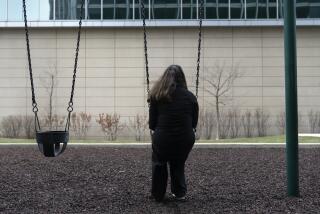Pros and cons of screening teens for depression
- Share via
By the time a teenager graduates high school, about one out of nine of his or her peers has attempted suicide. Suicide is the third leading cause of death among young people, behind car accidents and homicide, and 10% to 12% of teens ponder suicide every day.
The issue: Some pediatricians and mental health professionals believe that many teen suicides can be prevented through a five- to 10-minute questionnaire that singles out at-risk teens for follow-up diagnosis and treatment. TeenScreen, developed at Columbia University and already deployed in some schools and doctors offices in 43 states, is the most well-known program. It asks questions about symptoms related to depression, anxiety, drug use and suicidal thoughts.
In March, the U.S. Preventive Services Task Force, a government panel that reviews evidence and develops recommendations for preventive services, effectively reversed earlier rulings and recommended screening adolescents (ages 12 to 18) for major depressive disorder in doctor’s offices, provided there are resources available for follow-up and treatment.
“It’s a very strong endorsement of screening,” says pediatrician Thomas DeWitt of the Children’s Hospital Medical Center in Cincinnati, who led the national panel.
But the recommendations have done little to quell skepticism about suicide and depression screenings. In 2005, TeenScreen became the subject of a lawsuit after Indiana parents sued their children’s school for administering the test without their consent in a case that has yet to go to trial. Some mental health experts say screening will stigmatize the 28% to 44% of students flagged for suicide risk via the questionnaire even if follow-up fails to confirm their at-risk status.
Others note that normal adolescents are often moody and that overdiagnosis of major depressive disorder, which affects just 5.6% of teens, could lead to increased use of selective serotonin reuptake inhibitors, such as Prozac, that have been linked to and increased risk of suicide.
Others say that suitable treatment is not available to many who would be identified in school- or community-based screens, where methods have not proved as effective as in primary care settings.
Even if teenagers are properly identified, they say, drug treatments benefit only one in five teen patients, and it is not clear that resources are available to provide behavioral therapy as recommended by the task force. Read on for two opposing expert views on the issue.
Screening can save teenagers
James Mazza, a psychologist at the University of Washington in Seattle, who has studied mental health screening for 20 years, says the task force’s proposals were not broad enough. He says that children can benefit from depression screenings as early second grade.
“Screening is a valuable way to proactively identify kids at risk of suicide. It allows kids to self-report to us what they are feeling and how they are feeling. You don’t see third- and fourth-graders walking into a counselor or principal’s office and saying: ‘I feel bad.’ Middle-schoolers and high-schoolers don’t tend to seek out help. They don’t have the experience to know what is normal.
“Screening doesn’t do diagnosing. It’s just a measure to say, ‘How are things going on in your life?’ Then a counselor can follow up and do a risk assessment interview or make an appropriate referral to someone who can do the risk assessment. If schools don’t screen, their students don’t have the opportunity to proactively identify themselves as at risk. On the flip side, not screening means we’ll do nothing and stick our heads in the sand and hope for the best, even though we know a significant number of youth experience these mental health issues.
“I believe treatment is available for schoolchildren. The U.S. is moving to a model of having pediatric psychology in schools. If a student gets screened and is identified as at risk for suicide, schools can provide them with someone to talk to regarding getting help. Our counselors don’t have to be ‘suicidologists.’ We don’t tell our counselors to treat broken legs either. Would it be nicer if the system of treatment was already in place? Absolutely. If we have to wait for every school to have a system in place, we’ll lose a lot of kids to suicides.
“Behavioral therapy has been found to be an excellent treatment, and psychopharmacological interventions do work. The U.S. Food and Drug Administration has approved SSRIs, including Paxil and Prozac, for adolescents, and the task force agrees. Although I’m not the biggest fan of drug interventions, they can be very effective during crisis situations. My treatment bias is for teens to learn good coping skills and decision-making strategies so they can take care of themselves when the next stressful situation or crisis occurs.
“When I get people who don’t like screening, I ask, ‘What else are you going to use to identify students who are depressed?’ They don’t have an answer.”
Why screen if you can’t treat?
Dr. Lawrence Diller, a pediatrician in Walnut Creek, Calif., and the author of several books critical of prescribing psychiatric drugs to children, worries that screening will be used in schools and other arenas where effective treatments are not available.
“In an ideal world, where counselors look beyond individual symptoms to incorporate family and school effects and a treatment besides psychiatric medicine, then a screening tool could be useful.
“There’s a little bit of data to indicate that screening methods work to identify depressed teens, but these are from well-funded academic screening programs. In the real world of public mental health, I seriously question whether this will be implemented the way these academic studies are performed. Screening should also not be implemented until there is an adequate nondrug intervention available.”No one would say preventing suicide is a bad thing. But researchers haven’t been able to link screening to a decrease in suicides. The Columbia TeenScreen criteria for depression are linked to suicidal thinking and intention, but I don’t believe teens necessarily have to be seriously depressed to take an action and kill themselves. A teen may make a gesture -- not a genuine suicide attempt -- but go too far and kill themselves.
“My main concern is that treatment will involve only the individual child and not larger societal problems. If you do the screening, you must be aware of the implications of screening and the effectiveness of treatment. The evidence for treatment of teenage depression is weak for both behavioral therapy and drug treatment. During the FDA hearings on SSRI drugs, there were 15 studies -- mostly industry-sponsored -- and only three of 15 showed positive evidence.
“The screen may be pulling out kids who are vulnerable, but it puts the focus entirely on them. In counseling, there is a strong tradition on focusing on the individual, but the kid may have a bad family situation. Will the mental health system be up to dealing with this? Or will we get a lot of red flags treated with nothing but psychiatric medicine and leaving the underlying causes unaddressed?
“An alternative to screening would be better mental health awareness programs, such as a video teaching teens about depression and suicide, and for counselors also to work with the teenager’s family and acknowledge the community situation.”
health@latimes.com
More to Read
Sign up for Essential California
The most important California stories and recommendations in your inbox every morning.
You may occasionally receive promotional content from the Los Angeles Times.










